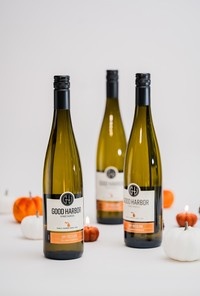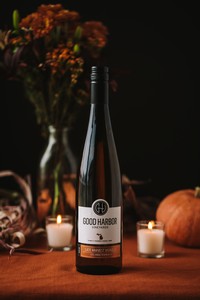Exploring Nature’s Sweet Nectar of Late Harvest Wines
Exploring Nature’s Sweet Nectar of Late Harvest Wines
 Late harvest (sweet) wines are a hidden gem in the world of winemaking, offering a unique and exquisite experience for wine enthusiasts. These delectable creations are a testament to the patience and artistry of winemakers who let their grapes linger on the vine, absorbing the essence of the sun and soil, until they reach a state of perfect ripeness. Join us as we go on a journey to uncover the captivating world of late harvest wines, exploring their origins, the meticulous process of crafting them, what grape varieties make the best sweet wines, and the best practice when it comes to pairing them with food.
Late harvest (sweet) wines are a hidden gem in the world of winemaking, offering a unique and exquisite experience for wine enthusiasts. These delectable creations are a testament to the patience and artistry of winemakers who let their grapes linger on the vine, absorbing the essence of the sun and soil, until they reach a state of perfect ripeness. Join us as we go on a journey to uncover the captivating world of late harvest wines, exploring their origins, the meticulous process of crafting them, what grape varieties make the best sweet wines, and the best practice when it comes to pairing them with food.
Background
If you aren’t familiar with sweet wines, you may think that winemakers add a lot of granulated sugar into the tank while the juice is fermenting to sweeten it. In reality, the sweetness level is created from the length of time the fruit hangs on the vines. Grapes used in late harvest wines are left on the vine after they’ve reached their peak ripeness. The longer they hang on the vine, the sweeter the grapes become over time as each individual grape dehydrates and the sugar content becomes more concentrated. Typically, this fruit is picked about one after the regular harvest time.
While any grape can be harvested late and used to make sweet wine, chances are you will see certain grapes chosen over others because they contain a higher level of acid that allows the wine to be produced in a sweet style and remain balanced.. The most commonly used varieties are:
Riesling
Experts explain that riesling is one of the most commonly used varieties that is used to produce late harvest wines. Due to its naturally high acidity, it makes an ideal candidate for the sweet style of wine. Some of the best late harvest Riesling wines come from cool climate growing regions including Germany, Northern France, New Zealand, Washington State, and right here in Northern Michigan.
Vidal Blanc
This grape variety is a hybrid species that is made up of European grapes crossed with American grapes. The crossing results in a very cold-hardy white grape that is remarkable for late harvest wines. The vine’s weather tolerance allows the grapes to be often left on the vine to suffer through winter’s first freeze and used to produce ice wines. Plantings of this variety can be found across the United States and is widely planted in Canada.
Sauternais
Sauternais is a blend of Sauvignon Blanc and Sémillon grapes grown in the Sauternes region of Bordeaux. The region is close to a foggy section of the Garonne river. The fog engulfs the vineyards and causes the grapes to be infected with a necrotrophic fruit fungus called Botrytis cinerea, or noble rot. Doesn’t sound too appealing, does it? In actuality, the mold sweetens the grapes and makes for a dessert wine that has exceptionally high sweetness.
Muscat
This is one of the oldest families of grapes in the world and contains several different varieties used in both white and red wines. While Muscat wines can be made in a wide range of styles, one of the most precious ones is late harvest wines that are made by several different methods around the world.
How To Make Sweet Wines
No matter the type of wine you are producing, there are multiple ways to go about it - depending on how you want the final product to turn out. Whichever way the winemaker chooses to make his or her late harvest wine, they are trying to boost the sugar levels - or stop it from being converted to alcohol - while preserving or boosting acidity to provide balance. Some of the best sweet wines in the world have high sugar levels and a high acidity. Five common ways to make sweet wine include:
Noble Rot
This may be the most interesting method to produce sweet wines. Like we mentioned above, noble rot is a fungus called Botrytis cinarea. Experts describe it as a wine “frenemy.” This is because if it comes at the right time, the result can be some of the world’s greatest sweet wine but if it comes at the wrong time, you’ve lost a lot - if not - all of your crop.
The perfect time is when the fungus attacks grapes that are already ripe on a misty morning before the afternoon sun dehydrates the grapes. This cycle will continue for a few days and the dual effect of the fungus will make a very interesting end product.
This method is known to be used widely throughout Sauternes and Barsac in Bordeaux, as well as Tokaji in Hungary. But it isn’t limited to these areas. It can also be found where climatic conditions are right. Noble rot results in very complex sweet wines that have a good balance between the acidity and sweetness.
But how does noble rot make the wine sweet? After pressing, the grape juice, or must, has a very high level of sugar in it and the fermentation stops after about 10-13% alcohol has been reached, which leaves lots of sugar left in the final wine. Something winemakers need to remember is that 16 grams of sugar is needed to make 1% alcohol. If the juice has 260 grams per litre of sugar, then ferments to 10%, there will be 100 g/l of residual sugar left.
Fortification
Fortification is another widely used method to make sweet wines. When using the method, if high strength brandy is added to a fermenting wine, it will kill all of the yeasts and leave a wine with lots of sugar in it.
The most famous fortified wine you would know, and without knowing it, would be Port. This comes from the Douro region in Portugal. For Port, the fermentation process only takes part for a couple of days before the brandy is added. Another popular wine, Sherry, goes through the fortification method - but the winemaking process is different. While most Sherries are dry, there are some made from the Pedro Ximenez grape that make very rich, sweet wines from raisining harvested grapes in the sun.
There is a problem when it comes to using the fortification method though. When wines go through this method, the fermentation only goes a short way so the young wines going through it miss out on some of the complexity that comes from the metabolic activity of the yeasts.
Drying Grapes
Sugar levels in grapes can be boosted by drying them out. This process can take place on mats in the vineyards or special drying sheds. The idea of this method is similar to botrytis. By desiccating the grapes, sugar and acid are increased and fermentation stops leaving lots of sugar in the finished wine.
Late Harvest
This method is the simplest method when it comes to making sweet wines. At Good Harbor Vineyards, all of our sweet wines go through this method. It involves picking grapes late when their sugar levels are high.
Ice Wine
This method of making sweet wines is one of the most extreme. That is because the grapes are left on the vine until they freeze before being harvested. This fruit is usually picked at below freezing temperatures because the water freezes and all that comes out when the berries are crushed is an unctuous nectar that is very high in sugar and acidity. While ice wines can be produced around the world, they can reach their highest level of quality and notoriety in three places: Canada, particularly in Ontario (east) and British Columbia (west), upstate New York, and Germany. The Leelanau Peninsula is also one area in which ice wine can be produced.
 How To Pair With Food
How To Pair With Food
No matter what wine you are drinking, you can find a food that goes well with it. But, there are some wines that are harder than others to pair.
A simple way to test if a food matches with a wine is this: take a bite of food, chew a bit and then sip a little bit of the wine. If the wine adds something positive or a complementary flavor, then you’re good to go. If you’re looking to match sweet white wines, take note of their basic flavor components of sweetness, tartness, and medium-light intensity. These attributes will be handy when it comes to the components of a dish.
When pairing sweet wines with food, remember these tips:
- Spicy Food: If the wine is served chilled, sweet white wines with low alcohol are a great match with hot and spicy food
- Salty Food: When combining sweet white wines with salty foods, a highly desirable sweet-salty effect is produced
- Sour Food: If the sweet white wine has high acidity - like Riesling - can handle sour vinegar-based sauces
- Light Meats: The light-to-medium intensity in sweet white wines match well with light-to-medium intensity meats and tofu
- Sweet Sauces: If looking to pair a sweet sauce with a sweet white wine, look for Asian sauces with sugar, tamarind or honey
- No Chocolate: Desserts with caramel, butterscotch, fruit, vanilla or coconut pair very well with sweet white wines
Late harvest wines represent a delightful culmination of nature’s patience and winemakers’ expertise. These wines offer a unique character that are forged through the concentration of sugars and flavors during extended hang times on the vine and offer a sensory journey that captivates the palate. Whether sipped as a sweet finale to a meal or savored on a crisp autumn evening, late harvest wines invite us to appreciate the artistry of winemaking and the nuances of each grape variety.
Good Harbor Vineyards has a wide variety of sweet wines available. If you haven’t tried one of our sweet wines, we encourage you to come visit us and see what the hype is all about.
Comments
Commenting has been turned off.Recent Posts
-
August 21, 2025
-
August 9, 2025
-
July 1, 2025
-
June 3, 2025
-
May 2, 2025
-
April 9, 2025
-
March 6, 2025
-
February 11, 2025
-
January 10, 2025
-
December 12, 2024